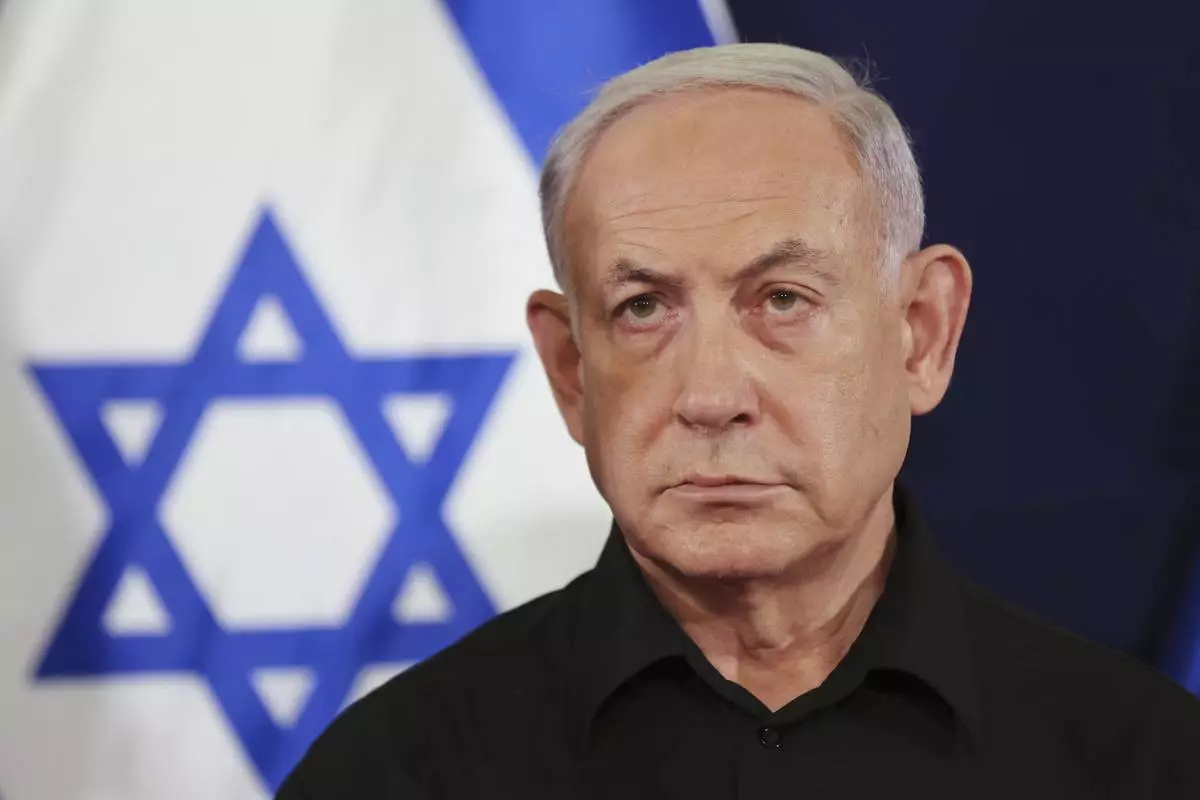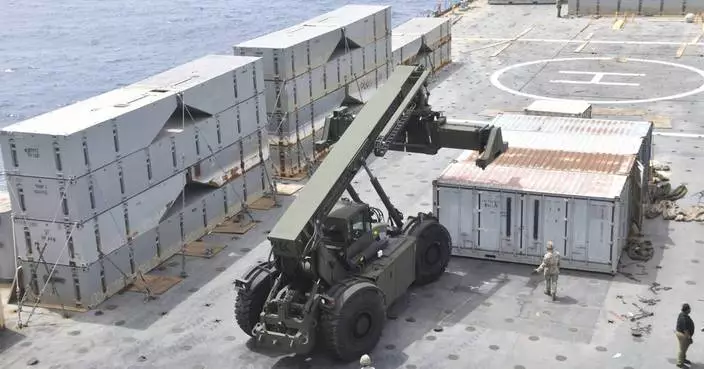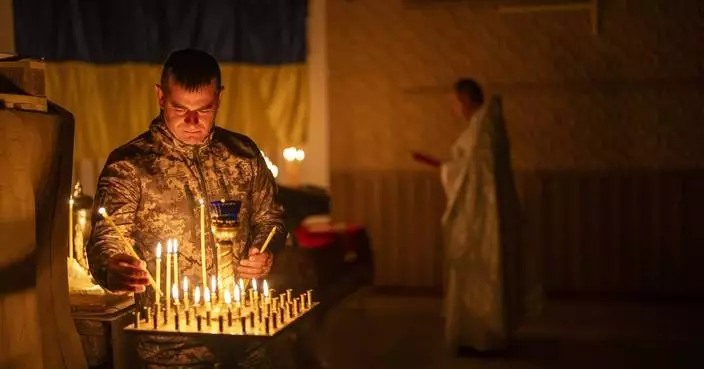It's a major contributor to climate change — the way buildings and roads are made with concrete. It's also a problem that's growing as more of the world develops. So the race has been on to find solutions for a material that's responsible for roughly 8% of global carbon dioxide emissions.
Now one California startup has developed a technology that reduces carbon dioxide in the making of cement and could have the potential to operate at large scale. Fortera intercepts carbon dioxide exhaust from the kilns where cement is made and routes it back in to make additional cement. In its first effort at commercial scale, the technology is being added to a CalPortland facility in Redding, California, one of the largest cement plants in the western U.S. It opens Friday.
“Our target is about being a ubiquitous solution that can work really at any plant,” said Ryan Gilliam, Fortera CEO.
Initially Fortera will produce enough to mix with about one-fifth of CalPortland's product in a blend that reduces carbon by about 10%. Gilliam said there is a strong demand for higher blends that reduce carbon by 40-50%, and for a pure product the company makes, which has 70% lower carbon.
The first large sacks are scheduled to move out the door of the Redding plant the first week of May.
Fortera evolved in part out of an earlier company called Calera that was among the first to convert carbon dioxide into cement starting in 2007. It poured some 100 tons of its low-carbon cement into California office buildings and sidewalks but shuttered in 2014 due to financial challenges. Building on that knowledge, Gilliam founded Fortera in 2019 with several former Calera employees.
There is “pretty much a cement plant every 250 miles in the world,” he said, and most are located near a limestone quarry. Because it works with these existing plants and uses the same material the industry already uses, Fortera says its technology is an economically competitive option to quickly prevent carbon emissions from warming the planet.
One difference from some other low-carbon cement and concrete efforts is it offers at least the possibility of being installed widely at cement plants instead of changing how the industry currently runs.
Fortera’s is one of many efforts to reduce the climate impact of concrete. The American Institute of Architects educates many of the world’s largest architecture firms about carbon emissions from building materials.
Some jurisdictions including Vancouver, British Columbia have building standards that encourage lower-carbon concrete. California passed a law in 2021 that requires the state’s Air Resources Board to develop a strategy for the state’s cement industry to reduce its greenhouse gas emissions by 40% by 2035 and achieve net zero by 2045.
The First Movers Coalition, an organization of more than 90 companies, has an initiative announced in 2021 to create greater demand for low-carbon cement through their immense buying power.
The same year, 40 of the largest cement and concrete manufacturers announced a commitment to making concrete that does not contribute to climate change by 2050 through the Global Cement and Concrete Association. They agreed to reduce emissions from cement, fossil fuel use in manufacturing processes and to develop new ways to capture carbon.
Concrete is the second -most used product on Earth, aside from water. Cement makes up 10-15% of concrete by volume, but accounts for 88% of concrete’s considerable emissions. Other ingredients in concrete are sand, gravel, crushed stone and water.
Manufacturing one ton of cement emits nearly one ton of carbon dioxide. There hasn't been a simple replacement.
“The societal benefits of concrete are absolutely immense … it’s the backbone of modern society,” said Thomas Guillot, CEO of the Global Cement and Concrete Association. Other materials sometimes fail to compete because they are not as durable, can't support as much weight, or can't stand up as well to heat, he said.
HOW FORTERA'S TECHNOLOGY WORKS
Cement manufacturers heat kilns to about 2,500°F (1,400°C) to break down limestone and separate it into carbon dioxide and calcium oxide.
Fortera's process sucks the carbon dioxide out and pipes it into a machine where it is turned into a solid. Its technology works at around 1,800°F (1,000°C), which requires less energy and emits less carbon.
When the captured carbon dioxide is mixed with calcium oxide, it turns into a kind of limestone that becomes cement-like when wet. This product, which Fortera calls ReAct, is blended with other ingredients to make concrete.
Fortera uses a 15% blend of ReAct in concrete because that is all that is allowed under existing industry standards that regulate material strength and durability.
The company is trying to get a product that is 100% ReAct approved as a replacement for cement and says its testing has shown it can meet international requirements, but the regulatory process will take over five years.
Some of the fastest-growing consumers of cement are in Southeast Asia and Africa, so global solutions are critical.
“The United States has to do what it can and be a leader to help other countries,” said Mike Ireland, president and CEO of the Portland Cement Association, the national trade association for U.S. cement manufacturers. “But we have to get the rest of the world, particularly the Global South, as they industrialize to leapfrog some of the technologies we had.”
Carbon emissions from cement manufacturing is “an existential threat to the world and for our industry,” he said.
The Associated Press’ climate and environmental coverage receives financial support from multiple private foundations. AP is solely responsible for all content. Find AP’s standards for working with philanthropies, a list of supporters and funded coverage areas at AP.org.
TEL AVIV, Israel (AP) — Israel ordered the local offices of Qatar's Al Jazeera satellite news network to close Sunday, escalating a long-running feud between the broadcaster and Prime Minister Benjamin Netanyahu's hard-line government as Doha-mediated cease-fire negotiations with Hamas hang in the balance.
The extraordinary order, which includes confiscating broadcast equipment, preventing the broadcast of the channel’s reports and blocking its websites, is believed to be the first time Israel has ever shuttered a foreign news outlet.
The network has reported the Israeli-Hamas war nonstop since the militants' initial cross-border attack Oct. 7 and has maintained 24-hour coverage in the Gaza Strip amid Israel's grinding ground offensive that has killed and wounded members of its own staff. While including on-the-ground reporting of the war's casualties, its Arabic arm often publishes verbatim video statements from Hamas and other militant groups in the region, drawing Netanyahu's ire.
“Al Jazeera reporters harmed Israel’s security and incited against soldiers,” Netanyahu said in a statement. “It’s time to remove the Hamas mouthpiece from our country.”
Al Jazeera issued a statement vowing it will “pursue all available legal channels through international legal institutions in its quest to protect both its rights and journalists, as well as the public’s right to information.”
“Israel’s ongoing suppression of the free press, seen as an effort to conceal its actions in the Gaza Strip, stands in contravention of international and humanitarian law,” the network said. “Israel’s direct targeting and killing of journalists, arrests, intimidation and threats will not deter Al Jazeera from its commitment to cover, whilst more than 140 Palestinian journalists have been killed since the beginning of the war on Gaza.”
Israeli media said the order allows Israel to block the channel from operating in the country for 45 days.
The Israeli government has taken action against individual reporters over the decades since its founding in 1948, but broadly allows for a rambunctious media scene that includes foreign bureaus from around the world, even from Arab nations. That changed with a law passed last month, which Netanyahu's office says allows the government to take action against a foreign channel seen as “harming the country.”
Immediately after the announcement, Al Jazeera's English arm began broadcasting a prerecorded message from one of its correspondents from a hotel the channel has used for months in east Jerusalem, which the Palestinians hope to one day have for their future state.
“They're also banning any devices — that includes my mobile phone,” correspondent Imran Khan said. "If I use that to do any kind of newsgathering, then the Israelis can simply confiscate it.”
Al Jazeera went off Israel's main cable provider in the hours after the order. However, its website and streaming links across multiple online platforms still operated Sunday.
The ban did not appear to affect the channel’s operations in the occupied West Bank or Gaza Strip, where Israel wields control but which are not sovereign Israeli territory.
The decision threatens to heighten tensions with Qatar at a time when the Doha government is playing a key role in mediation efforts to halt the war in Gaza, along with Egypt and the United States.
Qatar has had strained ties with Netanyahu in particular since he made comments suggesting that Qatar is not exerting enough pressure on Hamas to prompt it to relent in its terms for a truce deal. Qatar hosts Hamas leaders in exile at a political office in Doha.
The sides appear to be close to striking a deal, but multiple previous rounds of talks have ended with no agreement.
In a statement Sunday, Hamas condemned the Israeli government order, calling on international organizations to take measures against Israel.
Shortly after the government's decision, Cabinet members from the National Unity party criticized its timing, saying it “may sabotage the efforts to finalize the negotiations and stems from political considerations.” The party said that in general, it supported the decision.
Israel has long had a rocky relationship with Al Jazeera, accusing it of bias. Relations took a major downturn nearly two years ago when Al Jazeera correspondent Shireen Abu Akleh was killed during an Israeli military raid in the occupied West Bank.
Those relations further deteriorated following the outbreak of Israel’s war against Hamas on Oct. 7, when the militant group carried out a cross-border attack in southern Israel that killed 1,200 people and took 250 others hostage. Since then, the Israeli military campaign in Gaza has killed over 34,000 people, according to local health officials there, who don't break figures down into civilians and combatants.
In December, an Israeli strike killed an Al Jazeera cameraman as he reported on the war in southern Gaza. The channel’s bureau chief in Gaza, Wael Dahdouh, was wounded in the same attack. Dahdouh, a correspondent well-known to Palestinians during many wars, later evacuated Gaza but only after Israeli strikes killed his wife, three of his children and a grandson.
Al Jazeera is one of the few international media outlets to remain in Gaza throughout the war, broadcasting bloody scenes of airstrikes and overcrowded hospitals and accusing Israel of massacres.
Israel accuses Al Jazeera, funded by Qatar's government, of collaborating with Hamas. Criticism of the channel is not new, however. The U.S. government singled out the broadcaster during America’s occupation of Iraq after its 2003 invasion toppled dictator Saddam Hussein and over airing videos of the late al-Qaida chief Osama bin Laden.
Al Jazeera has been closed or blocked by other Mideast governments. Those include Saudi Arabia, Jordan, the United Arab Emirates and Bahrain during a yearslong boycott of Doha by the countries amid a yearslong political dispute that ended in 2021.
In 2013, Egyptian authorities raided a luxury hotel used by Al Jazeera as an operating base after the military takeover that followed mass protests against President Mohammed Morsi. The channel was apparently targeted over its constant coverage of Muslim Brotherhood protests over Morsi’s ouster.
Three Al-Jazeera staff members, Australian Peter Greste, Egyptian-Canadian Mohamed Fahmy and Egyptian producer Baher Mohamed received 10-year prison sentences, but were released in 2015 following widespread international criticism.
Gambrell reported from Jerusalem. Associated Press writer Jack Jeffrey in Jerusalem contributed.

FILE - Israeli Prime Minister Benjamin Netanyahu attends a press conference in the Kirya military base in Tel Aviv, Israel on Oct. 28, 2023. Netanyahu pledged Tuesday, April 30 to launch an incursion into the southern Gaza city of Rafah, where hundreds of thousands of Palestinians are sheltering from the almost 7-month-long war, just as cease-fire negotiations between Israel and Hamas appear to be gaining steam. (Abir Sultan/Pool Photo via AP, File)










